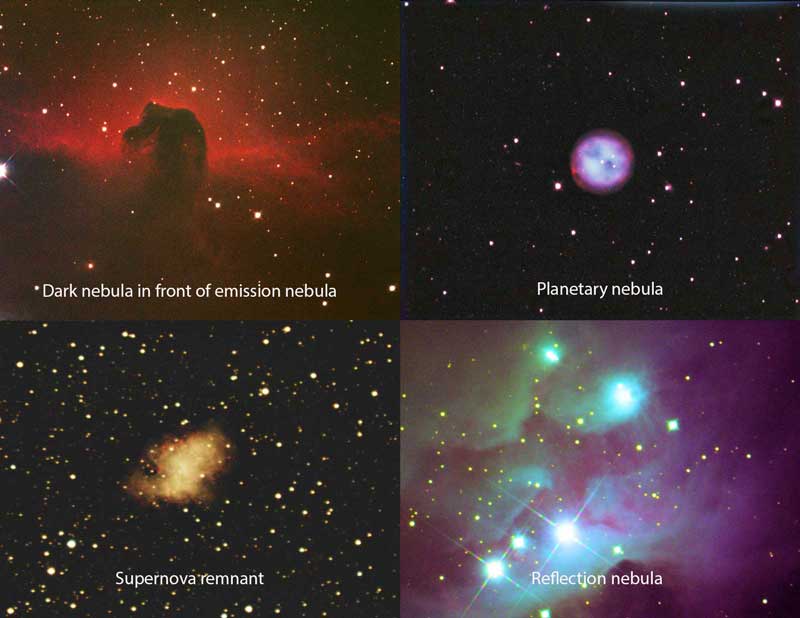A quick look at some nebulae
Where are they?
All the nebulae we see are in our own Milky Way galaxy unlike the very much more distant galaxies we can see. So the furthers are thousands of light years away rather than millions.
What are they?
A nebula (Latin for ‘cloud’ or ‘fog’) is an interstellar cloud of dust, hydrogen, helium and other ionized gases. Originally, the term was used to describe any diffused astronomical object, including galaxies beyond the Milky Way. The Andromeda Galaxy, for instance, was once referred to as the Andromeda Nebula before the true nature of galaxies was confirmed in the early 20th century by Vesto Slipher, Edwin Hubble and others.
Most nebulae are of vast size; some are hundreds of light-years in across. A nebula that is visible to the human eye from Earth would appear larger, but no brighter, from close by. The Orion Nebula, the brightest nebula in the sky and occupying an area twice the diameter of the full Moon, can be seen with the naked eye.
Although denser than the space surrounding them, most nebulae are far less dense than any vacuum created on Earth – a nebular cloud the size of the Earth would have a total mass of only a few kilograms. Many nebulae are visible due to fluorescence caused by embedded hot stars, while others are so diffused that they can be detected only with long exposures and special filters. Nebulae are often star-forming regions, such as in the “Pillars of Creation” in the Eagle Nebula. In these regions, the formations of gas, dust, and other materials “clump” together to form denser regions, which attract further matter, and eventually will become dense enough to form stars. The remaining material is then believed to form planets and other planetary system objects.

Types of Nebulae.
1. Diffuse Nebulae – Emission and Reflection
Most nebulae can be described as diffuse nebulae, which means that they are extended and contain no well-defined boundaries. Diffuse nebulae can be divided into
(a) emission nebulae which emit radiation from excited or ionized gas.
(b) reflection nebulae which are visible primarily due to the light they reflect. Reflection nebulae themselves do not emit significant amounts of visible light but are near stars and reflect light from them.
(c) dark nebulae which are similar in basic structure to reflection nebulae but have no nearby stars to reflect light from. They are detected as opaque clouds blocking light from luminous objects behind them.
2. Planetary Nebulae
Planetary nebulae are the remnants of the final stages of stellar evolution for lower-mass stars. Evolving to be giants stars expel their outer layers outwards due to strong stellar winds, thus forming gaseous shells, while leaving behind the star’s core in the form of a white dwarf. Radiation from the hot white dwarf excites the expelled gases, producing emission nebulae with spectra similar to those of emission nebulae found in star formation regions.
Planetary nebulae were given their name by the first astronomical observers who were initially unable to distinguish them from planets, and who tended to confuse them with planets, which were of more interest to them. Our Sun is expected to spawn a planetary nebula about 12 billion years after its formation.
3. Supernovae remnants
A supernova occurs when a high-mass star reaches the end of its life. When nuclear fusion in the core of the star stops, the star collapses. The gas falling inward either rebounds or gets so strongly heated that it expands outwards from the core, thus causing the star to explode. The expanding shell of gas forms a supernova remnant, a special diffuse nebula. Although much of the optical and X-ray emission from supernova remnants originates from ionized gas, a great amount of the radio emission is produced in a different way. This emission originates from high-velocity electrons oscillating within magnetic fields and is called synchrotron radiation